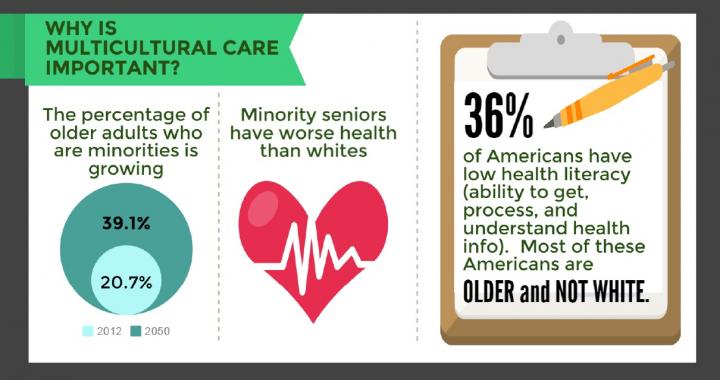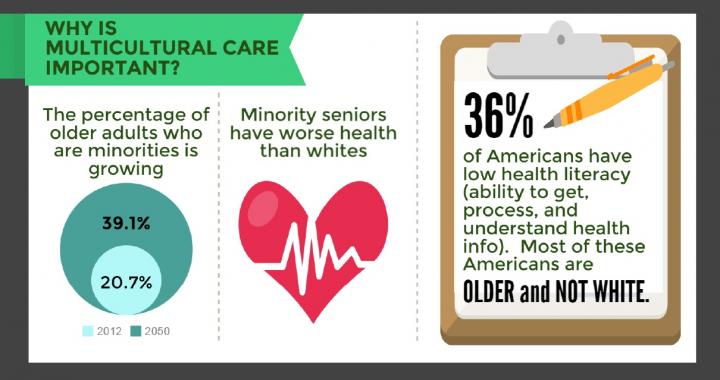
IMAGE: New guidance from the American Geriatrics Society (AGS) aims to transform approaches to healthcare for our increasingly diverse older population. Developed by a committee of experts in ethnogeriatrics (the study…
Credit: (C) 2016, American Geriatrics Society
New guidance from the American Geriatrics Society (AGS) aims to transform approaches to healthcare for our increasingly diverse older population. Developed by a committee of experts in ethnogeriatrics (the study of how ethnicity and culture impact the health and well-being of older people), "Achieving High-Quality Multicultural Geriatric Care" outlines present health disparities and the need for sensitivity to culture and health literacy when working with older individuals. As we look toward a not-so-distant future in 2050 when more than 80 million Americans will be 65-years-old or older, the factors outlined by AGS experts represent aspirational hallmarks of health care for a nation where "minorities" will soon account for nearly 40 percent of all older adults.
"With 10,000 people across the U.S. turning 65 every day, virtually all doctors, nurses, social workers, and other health professionals will soon be caring for older adults–and importantly, older adults who are more diverse than ever before," explains VJ Periyakoil, MD, Chair of the AGS Ethnogeriatrics Committee. "The AGS believes that providing high-quality care for older adults means helping healthcare professionals practice self-awareness, develop interpersonal skills, and become skilled in providing respectful care that meets the unique needs of our richly diverse older adult population," Dr. Periyakoil added.
While health inequities are already well-documented among older people, they are even more pronounced for multi-cultural older Americans. Minority individuals over age 65 have higher rates of disease and disability when compared with Caucasian men and women, for example. Furthermore, of the 36 percent of Americans who report limited health literacy (the ability to obtain, process, and understand basic health information), most are older, less educated, and not white. And as AGS researchers note, mistrust of medicine and medical research remains a persistent barrier to high-quality multicultural care.
As outlined by experts in this new AGS position statement, delivering culturally effective care means exploring and being responsive to the unique care needs of each patient during every clinical encounter. Putting processes or systems in place to ensure that patients are asked about their ethnicity, their preferred language, their level of education, and their familiarity with helpful resources like interpreter services, for example, can go a long way toward incorporating an older person's identity into her or his care.
Healthcare professionals themselves also need to become skilled in communicating effectively with people from different backgrounds, particularly since a provider's personal values and beliefs might inadvertently impede care without a healthy dose of self-awareness. The new AGS position statement walks through several questions for self-reflection, each exploring an aspect of personal identity that can impact the complex, coordinated care that many older people need.
"Culturally sensitive care isn't just about language or helping 'someone else.' For a healthcare professional, it's also an honest and deeply personal reflection on the stigmas and health disparities attached to certain groups. It means looking at ways our own personal journeys influence perspective and how we might respond to older people who look different, sound different, need different resources, or approach well-being with unique values and beliefs," said Steven R. Counsell, MD, AGSF, AGS President. "As a tool for recognizing how we are different, this new guidance from the AGS also helps to uncover what we have in common: a desire for care that is high-quality, person-centered, and supportive of the values and expectations that inform who we are."
The new AGS position statement on high-quality multicultural geriatric care was published online ahead of print in the Journal of the American Geriatrics Society, and will be available for free from GeriatricsCareOnline.org, the online home for AGS resources and publications.
###
About the American Geriatrics Society
Founded in 1942, the American Geriatrics Society (AGS) is a nationwide, not-for-profit association of geriatrics healthcare professionals dedicated to improving the health, independence, and quality of life of older people. Its nearly 6,000 members include geriatricians, geriatric nurses, social workers, family practitioners, physician assistants, consulting pharmacists, and internists. The Society provides leadership to healthcare professionals, policymakers, and the public by implementing and advocating for programs in patient care, research, professional and public education, and public policy. For more information, visit americangeriatrics.org.
Media Contact
Daniel E. Trucil
[email protected]
212-822-3589
@AmerGeriatrics
http://www.americangeriatrics.org/





